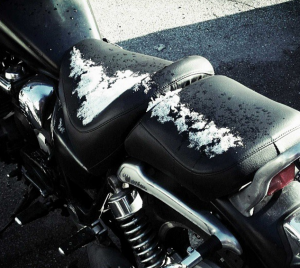Five Winter Parking Tips
Fall rides can be some of the best all year, but come October the nights grow longer and start to cool down and that little voice inside your head starts to whisper “Winter is coming! What are you gonna do about your bike?” Now that October is coming to a close, its a good time to think about how and wen you’ll be winterizing your bike, and we have five good tips…
1. Consider Your Climate – Unless you’re new to town you probably know how had your winter can get. From Portland to Boston, Seattle to D.C., winter woes vary, but if your temps dip below freezing and your plan on not riding during the winter you should be prepared. If you live in a cool dry location then you may not need to be as thorough in your winterizing techniques than the other side of the spectrum.
 2. Clean & Close Up – Give your bike a nice bath before winter hibernation. Getting all the grime off will allow you to properly lube as well. Also close off any openings where foreign objects can enter like the exhaust. Its common for little critters like mice to crawl up in there make their winter, home which can cause some serious problems down the line. Cover the end with a plastic bad or plastic wrap then tighten with a rubber band. If its already below freezing, make sure you dry off any excess moisture from your clean up so it doesn’t freeze on your bike.
2. Clean & Close Up – Give your bike a nice bath before winter hibernation. Getting all the grime off will allow you to properly lube as well. Also close off any openings where foreign objects can enter like the exhaust. Its common for little critters like mice to crawl up in there make their winter, home which can cause some serious problems down the line. Cover the end with a plastic bad or plastic wrap then tighten with a rubber band. If its already below freezing, make sure you dry off any excess moisture from your clean up so it doesn’t freeze on your bike.
3. Refill & Replenish – Do a fresh oil change to remove old oil that may have impurities that could ham your bike when cold. Lube your cables and electrical connections (with di-electric grease). Make sure you coolant is up to spec with the proper the fluid needed for the coldest temperature your climate may throw your way. You may here that you need fuel stabilizer, but many riders think its effects are myth so you can take it or leave it. Top off your tires to their max PSI and be ready for them to be a little low when you first roll out in the spring.
If you plan on keeping your battery installed in the bike, invest in a trickle charger that you can keep plugged in and attached to the bike while its stored. This will keep the battery from being killed in the cold. If you can’t hook up a trickle charger then remove the battery completely and store it in a cool dry place in your home or garage until you’re ready to ride again. The battery may still need to be fully charged before you ride again in the spring.
4. Cover & Store – Where do you plan on keeping your bike over the winter? Do you have a garage, is it heated? Will you be renting storage at a shared garage? Are you keeping it outside? Consider where your bike will be stored carefully. If you don’t have your own garage and live in a harsh climate, we recommend you find a shared garage or storage facility in your city. Many bike repair shops double as winter storage facilities in the winter can can cost as little as $50/mo. So for $200 you can be sure your bike wont get frost-bite.
If you have no other option but to store outside, we recommend that you do more than just keep your standard cover on your bike and let the snow pile up. There are a few different types of motorcycle covers and sheds that offer more protection. Check out this list to see what might be good for you. Make sure wherever you store your bike that its in a dry place to avoid rust and other water damage.
5. Ask Your Forum or Dealer – While there are a lot of general tips that apply to all bikes, certain makes and models may have different recommendations when prepping for hibernation. If you haven’t already, join a local forum and ask your peers how they winterize for your make & model. You can also stop by your local dealer or mechanic to get further insight on winterizing for your specific bike.
We hope these tips can help you this winter. If your curious on how to perform these specific tasks, consult your owner’s manual and check out this WikiHow article.
